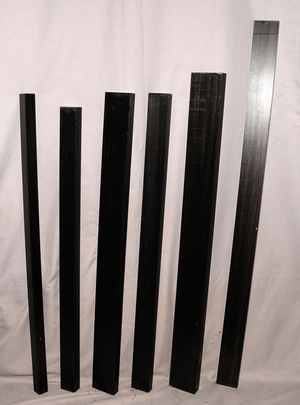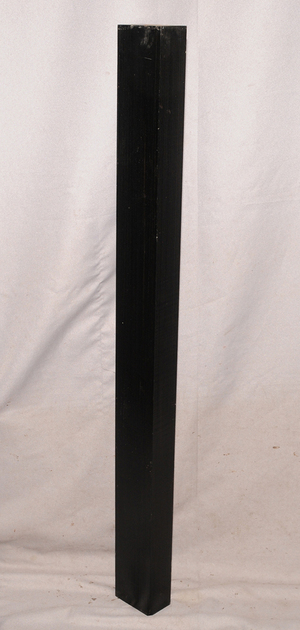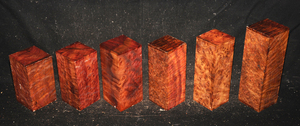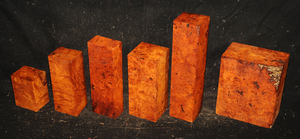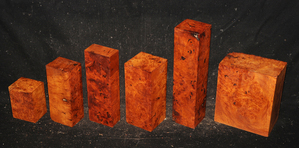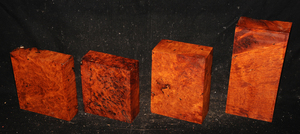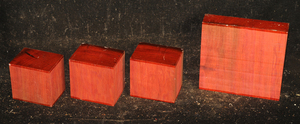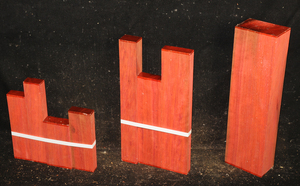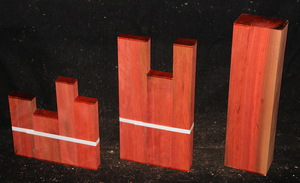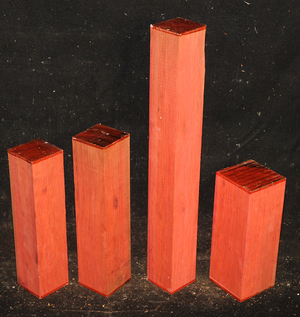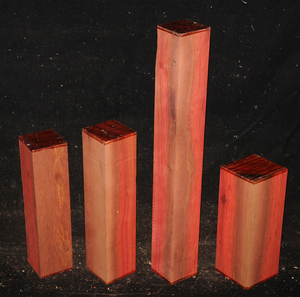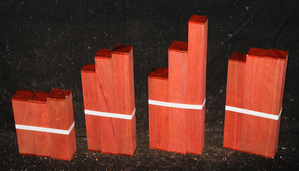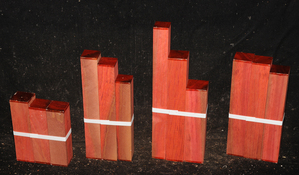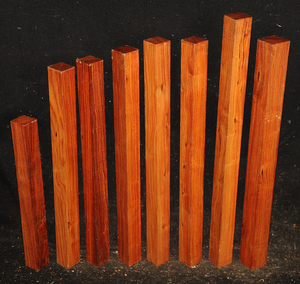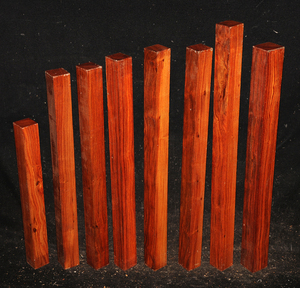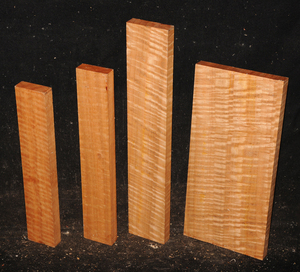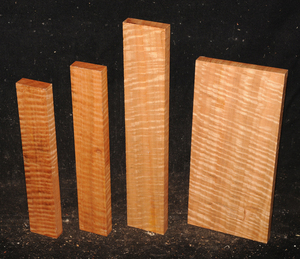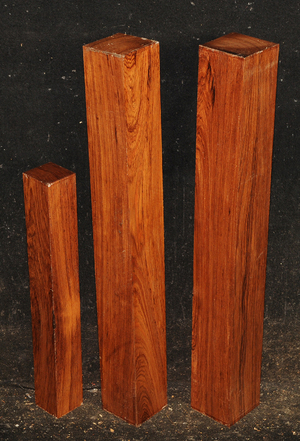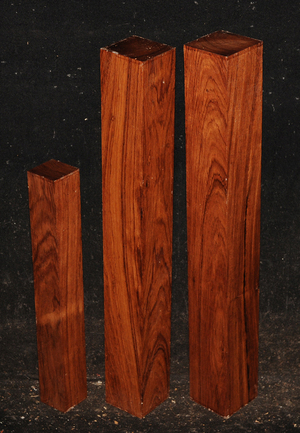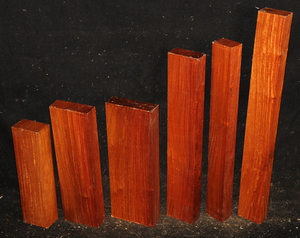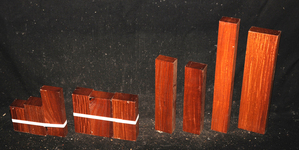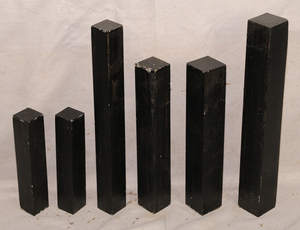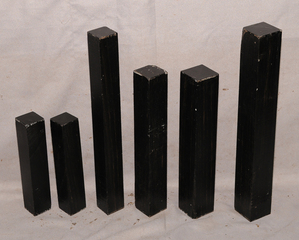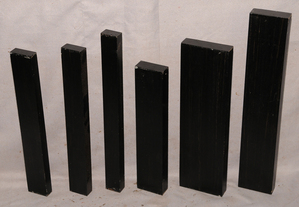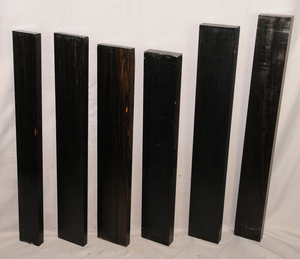West African Ebony
Diospyros crassiflora
Sometimes called Gabon or Gaboon, this Ebony is sometimes jet black but oftentimes has grayish streaks that mostly disappear when finished or after the made object has been put into service. This Ebony has a marked resistance to checking that is characteristic of some of the Indian and Asian species. It has a wonderful texture and is easily carved, planed, turned, and milled. It is fairly fine-grained and takes a high polish. This Ebony usually originates in either Cameroon or Nigeria and the logs are rough hewn in the forest and oftentimes brought to the nearest road by human porters. With the disappearance of other species of black Ebony this species is fast becoming the Ebony of choice.
Item Number: W43774
West African Ebony Guitar Neck Blank
Diospyros crassiflora
Sometimes called Gabon or Gaboon, this Ebony is sometimes jet black but oftentimes has grayish streaks that mostly disappear when finished or after the made object has been put into service. This Ebony has a marked resistance to checking that is characteristic of some of the Indian and Asian species. It has a wonderful texture and is easily carved, planed, turned, and milled. It is fairly fine-grained and takes a high polish. This Ebony usually originates in either Cameroon or Nigeria and the logs are rough hewn in the forest and oftentimes brought to the nearest road by human porters. With the disappearance of other species of black Ebony this species is fast becoming the Ebony of choice.
Item Number: IW37234
Camphor Burl Turning Squares
Cinnamomum sp.
This rare burl is from S.E. Asia and is seldom seen on the world market. It is fine-grained and varies in color from a light reddish-brown to almost scarlet. It is easy to work and has a very pungent, spicy scent. For a burl it is remarkably stable. Green to partially air dried.
Item Number: W43771
Camphor Burl
Cinnamomum sp.
This rare burl is from S.E. Asia and is seldom seen on the world market. It is fine-grained and varies in color from a light reddish-brown to almost scarlet. It is easy to work and has a very pungent, spicy scent. For a burl it is remarkably stable. Green to partially air dried.
Item Number: W43770
Makamong Burl
Afzelia xylocarpa
This is from S.E. Asia and is also called Makamong. We cut a large burl years ago into 4" to 6" slabs. The burl was old to begin with, and had been lying in a timber brokers yard for who knows how long. But it was long enough for pests to burrow through the sapwood and into a bit of the heartwood. The effects were incredible. It reminds me of an old dolomite cave complex after thousands of years of water erosion. Full of fissures and chasms, it is easy to visualize bats flying in and out or maybe a miniature version of Shelob's lair.
Item Number: W43765
Makamong Burl
Afzelia xylocarpa
This is from S.E. Asia and is also called Makamong. We cut a large burl years ago into 4" to 6" slabs. The burl was old to begin with, and had been lying in a timber brokers yard for who knows how long. But it was long enough for pests to burrow through the sapwood and into a bit of the heartwood. The effects were incredible. It reminds me of an old dolomite cave complex after thousands of years of water erosion. Full of fissures and chasms, it is easy to visualize bats flying in and out or maybe a miniature version of Shelob's lair.
Item Number: W43764
Chakte-kok Bowl Blanks
Cosmocalyx spectabilis
This species is from the Yucatan Peninsula of Mexico. It is also called Redheart. Freshly cut it is a brilliant red color which darkens on exposure.
Item Number: W43763
Chakte-kok Bundles & Block
Cosmocalyx spectabilis
This species is from the Yucatan Peninsula of Mexico. It is also called Redheart. Freshly cut it is a brilliant red color which darkens on exposure.
A has 4 pieces.
B has 3 pieces.
Item Number: W43762
Chakte-kok Turning Squares
Cosmocalyx spectabilis
This species is from the Yucatan Peninsula of Mexico. It is also called Redheart. Freshly cut it is a brilliant red color which darkens on exposure.
Item Number: W43761
Chakte-kok Turning Square Bundles
Cosmocalyx spectabilis
This species is from the Yucatan Peninsula of Mexico. It is also called Redheart. Freshly cut it is a brilliant red color which darkens on exposure.
Each bundle has 3 pieces.
Item Number: W43760
Pau Rosa Turning Squares/Pool Cue Blanks
Swartzia fistuloides
Hard & heavy & capable of a beautiful polish. Rare on the American market. Partially air dried.
Item Number: W43759
Figured Eucalyptus
Item Number: W43758
Honduras Rosewood Turning Squares
Dalbergia stevensonii
A true rosewood, most of our stock comes from Belize. Smelling like stored apples, it is a lovely wood to turn and takes a fantastic polish. Getting scarce on the world market.
Due to CITES regulations, we can only ship this species to customers in the United States.
Item Number: W43757
Figured Narra
Pterocarpus indicus
Also called New Guinea Rosewood. It is a beautiful, highly lustrous golden yellow color sometimes with reddish streaks. A nice turning wood it is also used in furniture, jewelry boxes, handles, etc. It is easy to work and glue and takes a nice polish.
Item Number: W43756
Figured Narra Bundles & Blocks
Pterocarpus indicus
Also called New Guinea Rosewood. It is a beautiful, highly lustrous golden yellow color sometimes with reddish streaks. A nice turning wood it is also used in furniture, jewelry boxes, handles, etc. It is easy to work and glue and takes a nice polish.
The bundles have 3 pieces each.
Item Number: W43755
West African Ebony Turning Squares
Diospyros crassiflora
Sometimes called Gabon or Gaboon, this Ebony is sometimes jet black but oftentimes has grayish streaks that mostly disappear when finished or after the made object has been put into service. This Ebony has a marked resistance to checking that is characteristic of some of the Indian and Asian species. It has a wonderful texture and is easily carved, planed, turned, and milled. It is fairly fine-grained and takes a high polish. This Ebony usually originates in either Cameroon or Nigeria and the logs are rough hewn in the forest and oftentimes brought to the nearest road by human porters. With the disappearance of other species of black Ebony this species is fast becoming the Ebony of choice.
Item Number: W43754
West African Ebony
Diospyros crassiflora
Sometimes called Gabon or Gaboon, this Ebony is sometimes jet black but oftentimes has grayish streaks that mostly disappear when finished or after the made object has been put into service. This Ebony has a marked resistance to checking that is characteristic of some of the Indian and Asian species. It has a wonderful texture and is easily carved, planed, turned, and milled. It is fairly fine-grained and takes a high polish. This Ebony usually originates in either Cameroon or Nigeria and the logs are rough hewn in the forest and oftentimes brought to the nearest road by human porters. With the disappearance of other species of black Ebony this species is fast becoming the Ebony of choice.
Item Number: W43753
West African Ebony
Diospyros crassiflora
Sometimes called Gabon or Gaboon, this Ebony is sometimes jet black but oftentimes has grayish streaks that mostly disappear when finished or after the made object has been put into service. This Ebony has a marked resistance to checking that is characteristic of some of the Indian and Asian species. It has a wonderful texture and is easily carved, planed, turned, and milled. It is fairly fine-grained and takes a high polish. This Ebony usually originates in either Cameroon or Nigeria and the logs are rough hewn in the forest and oftentimes brought to the nearest road by human porters. With the disappearance of other species of black Ebony this species is fast becoming the Ebony of choice.
D has a few small pinholes on the edge.
Item Number: W43751
Chakte-kok Lam Top Guitar Set
Cosmocalyx spectabilis
This species is from the Yucatan Peninsula of Mexico. It is also called Redheart. Freshly cut it is a brilliant red color which darkens on exposure.
Item Number: IW37231

